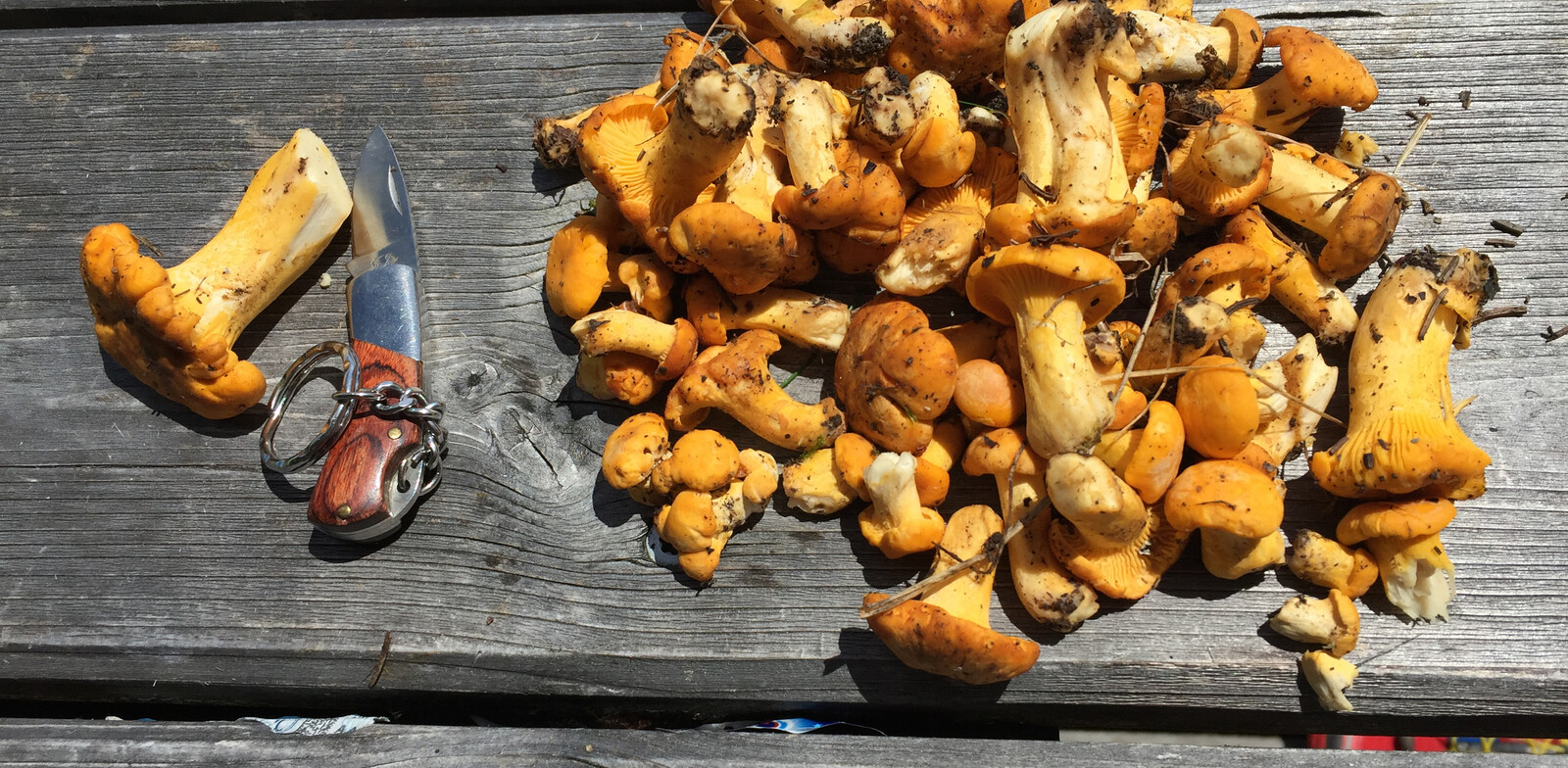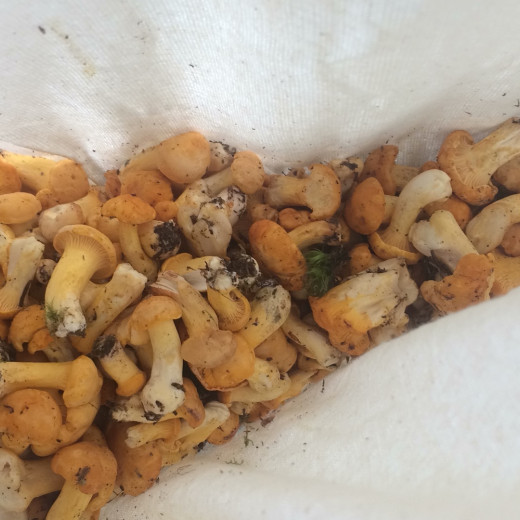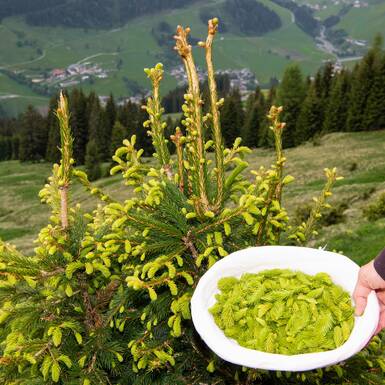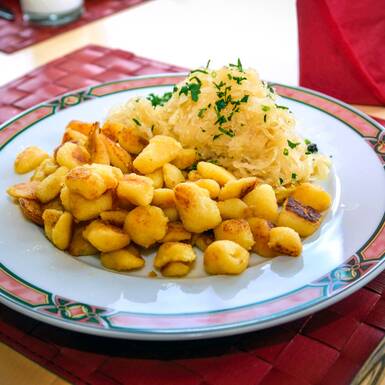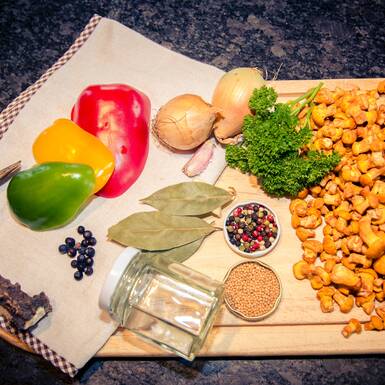- Traditions
The Mushroom Pickers‘ Code of Conduct
I definitely fall into the “Hunter and Collector” category. I only need to smell the aromatic scent of mushrooms in the woodlands on a humid day, and my hunter instinct kicks in as I pack my rucksack and venture out to collect mushrooms. For me searching for mushrooms has a meditative feel about it and my basic knowledge of collecting mushrooms such as; chanterelles, porcini mushrooms, ceps & Co. was passed down to me by my Dad.
A word in advance! Places, where mushrooms can be found, will not be revealed here (an unwritten law of collectors), and a step-to-step process won’t be outlined as the knowledge required is complex, and therefore the fundamental principle, which I am not aware of, remains a secret of the forest! I can remember quite clearly when a holiday guest stood before me with a basket full of (poisonous) mushrooms asking “Can you advise me on how many of these I can eat?” Well, you can consume all of them, but a couple of them you will eat only once. For if you handle a non-edible mushroom, this can lead to a nasty, even deadly poisoning. Also, it is forbidden to take mushrooms out of the forest indiscriminately. So, if in doubt, it’s best to head to the next restaurant to savour a dish of dumplings with mushrooms!
The Code of Conduct
There are no fixed guidelines for collecting mushrooms, although for real mushroom hunters a specific code of conduct is followed (such as not revealing the places where mushrooms can be found). Of the 8,800 known species of mushrooms in Austria, which incidentally do not belong to either the kingdom of animals or plants, there are only 100 species which are edible. There is a likelihood of confusion, and often even the comparison of pictures illustrated in a mushroom guidebook is not sufficient. I limit myself to collecting only chanterelles, ceps and porcini mushrooms. In certain instances, I will also pick parasol mushrooms. If in doubt, I leave mushrooms well alone especially if I am unsure whether it is a bitter bolete or not. Therefore, the following principles should be taken into consideration:
1. Do not pick what you cannot declare as an edible mushroom!
Those who would like to nurture and maintain the mushroom population should be cautious in their picking method and not disturb the shoots in and around where they are picking. Old and spoiled shoots should not be touched. I also leave toadstools well alone and take care not to tramp or step on them as they too play an important role in forest life and may serve other animals as food. Whether a mushroom is picked or cut is a matter of preference. Personally, I like to use a sharp mushroom knife, I also brush the mushrooms clean while I am still in the forest. What is essential and therefore the 2nd principle:
2. Leave rotten mushrooms where they are! Their spores ensure reproduction. Smooth over any earth that has been disturbed so that the mushroom spawn doesn't dry out and therefore remains for years to come.
An absolute no-go and already an environmental point of controversy is the plastic bag. If transported in a plastic bag the mushrooms will sweat and become mushy and spoilt. Ideal, although a little cumbersome for use in the forest is a wicker basket in which the mushrooms will remain secure and well-aired. A good compromise and therefore an item that should always be in carried in a rucksack is a linen bag.
3. Do not use a plastic bag to collect mushrooms! Better would be a basket or cotton-lined bag where the mushrooms will stay cool until you arrive home where they should be quickly processed.
The early bird catches the worm! Of course, but there are provisions in the law that mushroom collectors need to adhere to. In the province of Salzburg you may search for mushrooms between the hours of 07:00 until 19:00 hours (from October until 17:00). Restrictions, prohibitions and the designation of protected areas naturally also apply to mushroom seekers.
4. No early start in the forest – mushroom collecting only at the permitted times. The wildlife says thank you!
I revel in the tranquillity of the forest while keeping an eye out for the golden heads of the chanterelles. A roebuck passes in front of me, and at the same time, I hear delighted cries accompanied by shrill whistles “Where are you? I am over here”! The Roebuck has long ago bolted off, and I also leave the forest!
5. Mushrooming in groups: At peace in the forest! Always stay within sight and keep note of your walking direction and in between goals. There is not always a mobile phone reception, so remember to keep an eye out for the others in the group.
With all the hunting fever and euphoria that accompanies the search for the gold and brown caps- remember everything in moderation! The law regulates the quota of how many mushrooms can be collected per person, per day. The Salzburger Berg- und Naturwach are responsible for the supervision of the guidelines. The supervisory bodies are also authorised to make spot checks as well as take a look in your rucksack and if necessary confiscate mushrooms and make a formal report. Therefore:
6. Each person is entitled to collect not more than 2 kilogrammes of mushrooms per day. If mushrooming in a group, a collective amount of 8 kilogrammes of mushrooms are permitted if the mushrooms have not been collected separately. This regulation does not apply to landowners!
Back to the full basket of mushrooms that were presented to the staff at the Tourist Office. The Tourist Office is not responsible for regulating the number of mushrooms collected. Between mid-July and mid-October, every Monday at the Haus der Natur in Salzburg there is a session offering free advice on mushrooms between the hours of 15:00 to 17:00.
7. In the Haus der Natur, the mushroom expert offers advice on mushrooms every Monday. This advice will eliminate any worries you may have. If you take along a dubious mushroom from the forest, be sure that it transported carefully! With very poisonous mushrooms, even a piece that has broken off would make a dish inedible.
The province of Salzburg has designed a brochure on the theme of “Protecting Mushrooms in Salzburg”, in which you will find useful information on the protection of mushrooms, as well as prohibitions and requirements. You can download the brochure here. Good news for those who might have any misgivings: Nearly all local restaurants and huts offer mushroom dishes on their menu. Just take a seat, order and enjoy without hesitation!

